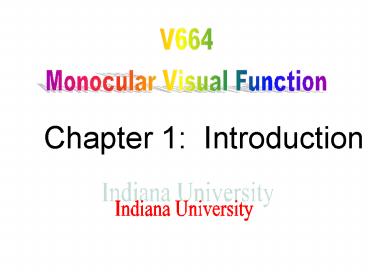Chapter 1: Introduction - PowerPoint PPT Presentation
1 / 11
Title:
Chapter 1: Introduction
Description:
7. Seeing flicker and movement. Invisible flicker. Does anything really move in ... ( retinal disease and flicker sensitivity, dyslexia). 8. An eye in motion. ... – PowerPoint PPT presentation
Number of Views:39
Avg rating:3.0/5.0
Title: Chapter 1: Introduction
1
Chapter 1 Introduction
2
Course Schedule
V664 meets for a 7 week period, five lectures
per week. 2002 Dates Feb 1 - March 25. Scheduled
lecture times Tue 12.20 - 2.15, Thur
11.15-12.05, Fri 10.10-12.05. Laboratory
Schedule M, T, W, F (2.30-4.25) Lab 1 Feb 28-
March 4. Lab 2 March 7-11 Final Exam
Tuesday, March 29, 12.10 -2.15 Office rm 516,
E-mail bradley_at_indiana.edu Course materials
located the Optometry Server BL-OPT-IUSO
/Teaching/V664 Slides also accessible from home
at www.opt.edu/v664
3
Course Goals
1. Learn the visual capabilities of a normal
visual system and how they vary with light level,
age, etc. 2. Understand the optical, anatomical
and neural factors that determine normal vision.
Remember, V663 (visual optics) and V648
(neurophysiology of vision) are pre-requisites
for this course. 3. Learn to specify and
calibrate stimuli used to test visual
performance. 4. Learn the science behind visual
testing. 5. Identify the common types of visual
loss and the underlying causes of vision loss.
4
Course Requirements/Recommendations 1. Read
all of Steve Schwartzs introductory book Visual
Perception, 2nd or 3rd edition. Up to 50 of
the final will come from this book (it is great
for National Boards). 2. Attend as many
lectures as possible (I recommend attending all).
Much of the material will involve complex
demonstrations which will not be available in the
class notes. 3. Active participation in and
completion of both labs is mandatory. Miss one
or more labs and you will fail this course. 4.
Final grade will be determined by performance on
1 quiz (20 each), a final exam (80). Final exam
questions will come from class and lab material
and Schwartzs book. 5. Recommended reading
The First Steps in Seeing by R.W. (excellent
book!).
5
Course Content (clinical application) 1. How
much light is in the stimulus? Radiometry and
photometry. Spectral Sensitivity. (danger of
lasers, standardizing clinical test light levels,
protecting the eye from hazards). 2. Does light
have color? How do we quantify color? How good
is color vision? How does it work? What do we
mean by color blind? (identifying color
deficient individuals) 3. How to ensure that
your patient can see the test target? The
science and clinical application of
psychophysics. (designing a clinical test,
improving a VA chart, sensitivity and
specificity) 4. Visual acuity the finest
visible detail, and why it has become a standard
optometric test. What is hyperacuity? Spatial
summation. (logMAR, Snellen, grating)
6
5. Visible Contrasts Defining how well we can
see larger objects. Impact of size (spatial
frequency), contrast, masking, adaptation,
eccentricity, light level (clinical CSF tests,
design and value, effects of defocus, cataracts,
visual field testing). 6. Changing
photoreceptors Rods to cones. Adaptation to
changing light levels.(night blindness, rod
monochromats) 7. Seeing flicker and movement.
Invisible flicker. Does anything really move in
a movie? What is visual persistence? Short and
long range motion, stopped motion, apparent
motion. (retinal disease and flicker sensitivity,
dyslexia).
7
8. An eye in motion. The impact of retinal
image motion on vision, blink and saccadic
suppression. Fixational eye movements and their
impact on vision. (impact of nystagmus and
unsteady fixation on vision) 9. Extracting the
3rd dimension from a 2 dimensional retinal image.
Monocular depth cues. Size constancy. (depth
perception in the stereo-blind) 10. The aging
visual system. How good is infant vision? What
visual changes occur with age? Optical and
anatomical changes. (clinical measurement of
infant vision, glare testing)
8
V664 Two Laboratories 1. Color Science and
Color Vision testing.Measure and quantify color.
Identify the correct methods for color vision
testing. 2. Contrast Sensitivity and Visual
Acuity Testing.Measure contrast sensitivity and
Visual Acuity using laboratory and clinical
tests. See impact of poor optics.
9
An explanatory note on exam grading
If you take a True/False exam and score 50
correct, how much do you know? If you take a
True/False exam and score 100 correct, how much
do you know? If you take a True/False exam and
score 75 correct , how much do you know?
Dr. Bradleys grading philosophy You must
demonstrate 50 knowledge to pass the course.
That is, on a T/F exam, you must score gt75 to
pass.
10
How important is V664? (3 credits in IU
curriculum)
National Boards 4 topic areas included in
V664 Visual Optics (Radiation and
Photometry) Visual Perception (color, form,
light, motion, temporal) Psychophysical methods
(threshold and suprathreshold, TSD) Human
Development (infant vision, aging
vision) Estimated of National Board
questions VO (radiom photom) 1-2 VP (w/o
binoc vision) 30-38 PM (whole
section) 3-7 HD (visual function) 12-14 Monoc
Vis Function Total 46-61 (3 credits)
18Q/credit Compare to Geo optics 15-19 (7
credits) 2.4Q/credit
Conclusion You MUST study hard and do well in
this course.
11
Look on the National Board web site
http//www.optometry.org/exam_descriptions.cfm to
see how the content of this course covers
material in section C and D of the basic science
exam. C. Visual Optics, radiometry and
photometry, retinal illuminance C. Visual
perception, everything except binocular vision
(covered in V666). D. Psychophysical methods
(all) D. Visual Development (about half of this
section)































